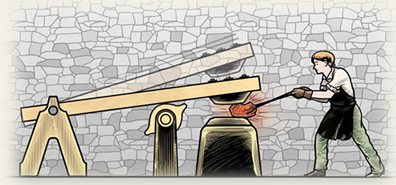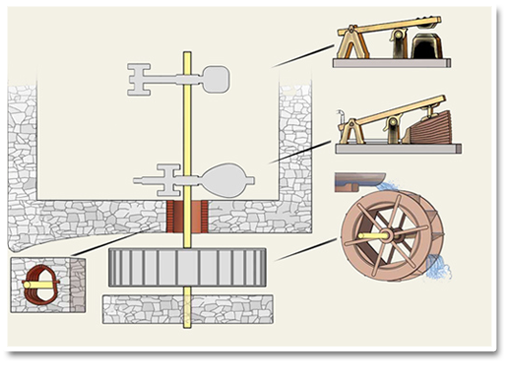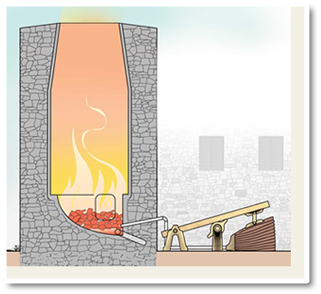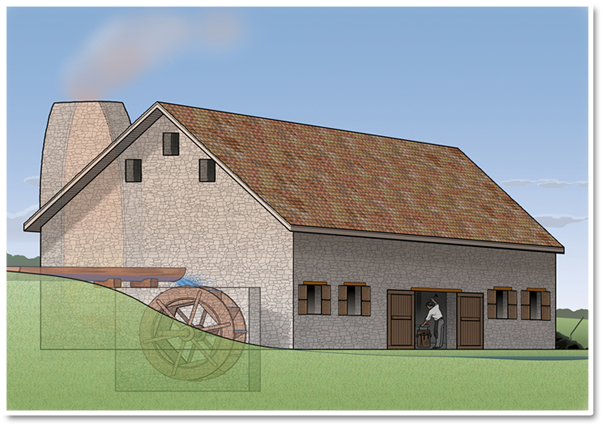Documentation and analysis of the identified features allowed for a possible interpretation of how this forge worked. This interpretation is based largely on forge mill descriptions and operations in general.
The purpose of the forge was to produce wrought iron. The forge may have operated as a bloomery, producing wrought iron from iron ore, or it may have functioned as a finery for producing wrought iron out of cast pig iron from a blast furnace. Illustration of iron being milled or hammered iron ore or pig iron was likely transported to the site via the road beside the forge and/or Furnace Avenue, which appears to have been present by 1794 (it appears on Griffith’s map of Maryland). Iron ore was readily available on the site and throughout the immediate area.
Illustration of iron being milled or hammered iron ore or pig iron was likely transported to the site via the road beside the forge and/or Furnace Avenue, which appears to have been present by 1794 (it appears on Griffith’s map of Maryland). Iron ore was readily available on the site and throughout the immediate area.

It is not known where pig iron might have come from. Perhaps there was a blast furnace located elsewhere on the property.
Iron refined in the forge was likely milled or hammered into various items, such as agricultural implements or weaponry. It is not known what, exactly, was produced on the site.
 Water from the headrace on the southwestern corner of the forge entered the wheel pit and drove the water wheel. The water power was derived from water moving downhill from a mill pond. The exact location of this pond was not determined. Based on the location of the mill race, it appears that a tributary of Stony Run was dammed for this purpose rather than Stony Run itself. Multiple parallel possible race segments were identified adjacent to the forge mill race, which may have fed other industrial operations. These races were uphill and west of the mill race along Stony Run that serviced Selby Mill.
Water from the headrace on the southwestern corner of the forge entered the wheel pit and drove the water wheel. The water power was derived from water moving downhill from a mill pond. The exact location of this pond was not determined. Based on the location of the mill race, it appears that a tributary of Stony Run was dammed for this purpose rather than Stony Run itself. Multiple parallel possible race segments were identified adjacent to the forge mill race, which may have fed other industrial operations. These races were uphill and west of the mill race along Stony Run that serviced Selby Mill.
The wheel was likely an overshot or breast-shot wheel, based on the location and height of the headrace above the forge. Unlike in a gristmill, the horizontal rotating motion could be used directly to drive hammers and bellows inside the forge building. The turning wheel shaft passed through the oval brick-lined opening in the south wall of the foundation.
Based on the results of monitoring excavation, it appears that the floor on the interior of the forge was approximately one foot below the base of the brick opening and wheel shaft. A possible stone platform was present on the southern end of the interior. This platform may have supported the anvil for the hammer. Workers would have heated iron and placed it into the hammers, which drove out impurities through force.
 The presence of black, burned soils on the west side of the interior of the forge suggests that the hearths may have been located on this side. The forge was built into the hillside to the west, which would have provided insulation for the hearths. Bricks observed across the site may have been part of the hearths and associated chimneys. The interior stone wall in line with the wheel shaft opening may have supported the bellows for the hearths.
The presence of black, burned soils on the west side of the interior of the forge suggests that the hearths may have been located on this side. The forge was built into the hillside to the west, which would have provided insulation for the hearths. Bricks observed across the site may have been part of the hearths and associated chimneys. The interior stone wall in line with the wheel shaft opening may have supported the bellows for the hearths.
In the finery hearth, a skilled worker called a finer heated the iron and burned off carbon and silicon creating a bloom. The bloom was then consolidated and refined through use of the water-powered hammers. This process was repeated until the iron was ready to be placed in the chafery hearth. There, workers reheated the bloom, hammered it into bars of different thicknesses for sale. Bar iron could be used to create wrought iron items.
It is likely that entrance to the forge building was on the east side, as this side was open at ground level, that is, not built into the hill side or the wheel pit. Significant amounts of window glass were observed in this area as well.

